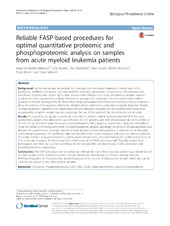| dc.contributor.author | Hernandez-Valladares, Maria | en_US |
| dc.contributor.author | Aasebø, Elise | en_US |
| dc.contributor.author | Mjaavatten, Olav | en_US |
| dc.contributor.author | Vaudel, Marc | en_US |
| dc.contributor.author | Bruserud, Øystein | en_US |
| dc.contributor.author | Berven, Frode | en_US |
| dc.contributor.author | Selheim, Frode | en_US |
| dc.date.accessioned | 2016-06-22T10:59:38Z | |
| dc.date.available | 2016-06-22T10:59:38Z | |
| dc.date.issued | 2016-06-21 | |
| dc.Published | Biological Procedures Online. 2016 Jun 21;18(1):13 | eng |
| dc.identifier.uri | https://hdl.handle.net/1956/12160 | |
| dc.description.abstract | Background Satisfactory sample preparation for mass spectrometry-based analysis is a critical step in the proteomics workflow. The quality and reproducibility of sample preparation can determine the coverage and confidence of proteomics results. Up to date, several methodologies have been described to produce suitable peptides for mass spectrometry analysis, followed by strategies for enrichment of post-translational modified peptides, if desired. Among them, the filter-aided sample preparation (FASP) has been introduced as a method to allow for removal of denaturants, reductants, alkylators, lipids and nucleic acids prior to trypsin digestion. Despite the high proteolytic digestion and contaminant removal efficiency described for this method, filter failure and consequently complete sample loss can discourage the use of this approach by the proteomic community. Results As judged by our quality controls, we were able to perform reliable and reproducible FASP for mass spectrometry analysis that allowed the quantification of 2141 proteins and 3694 phosphopeptides from as little as 20 and 320 μg of protein lysate from acute myeloid leukemia (AML) patients, respectively. Using the immobilized metal ion affinity chromatography (IMAC) method resulted in samples specifically enriched in phosphopeptides and allowed the quantification of a high number of both di- and multi-phosphopeptides in addition to the abundant mono-phosphopeptides. The workflows’ high reproducibility from three biological replicates was demonstrated by the similar number of quantified proteins and localized phosphosites, and confirmed by the similar distributions of their molecular functions. We found that the combination of the FASP procedure with StageTip mixed-mode fractionation and IMAC are excellent workflows for the reproducible and deep study of AML proteomes and phosphoproteomes, respectively. Conclusions The FASP procedure can be carried out without the risk of filter failure by performing a simple test of the filter quality before adding the protein sample. Herein, we demonstrate an efficient and reproducible FASP-based pipeline for the proteomic and phosphoproteomic analysis of AML patient samples which also can be used for the analysis of any other protein samples. | en_US |
| dc.language.iso | eng | eng |
| dc.publisher | BioMed Central | eng |
| dc.rights | Attribution CC BY 4.0 | eng |
| dc.rights.uri | http://creativecommons.org/licenses/by/4.0 | eng |
| dc.subject | Proteomics | eng |
| dc.subject | Phosphoproteomics | eng |
| dc.subject | FASP | eng |
| dc.subject | IMAC | eng |
| dc.subject | SILAC | eng |
| dc.subject | Mass spectrometry | eng |
| dc.subject | Acute myeloid leukemia | eng |
| dc.title | Reliable FASP-based procedures for optimal quantitative proteomic and phosphoproteomic analysis on samples from acute myeloid leukemia patients | en_US |
| dc.type | Peer reviewed | |
| dc.type | Journal article | |
| dc.date.updated | 2016-06-21T16:03:07Z | |
| dc.description.version | publishedVersion | en_US |
| dc.rights.holder | Copyright The Author(s) 2016 | |
| dc.identifier.doi | https://doi.org/10.1186/s12575-016-0043-0 | |
| dc.subject.nsi | VDP::Medisinske Fag: 700 | en_US |

